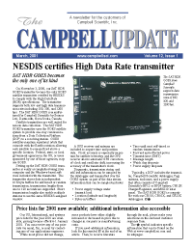SAT HDR GOES becomes the only one of its kind
On November 3, 2000, our SAT HDR GOES transmitter became the only GOES satellite transmitter certified by NESDIS to comply with the High Data Rate (HDR) specifications. The transmitter supports both low and high data transmission rates including 100, 300, and 1200 bps. The SAT HDR GOES is manufactured for Campbell Scientific by Seimac Ltd., Dartmouth, Nova Scotia, Canada.
Satellite transmitters are well suited for remote data collection. The SAT HDR GOES transmitter uses the GOES satellite system to provide one-way communications from a Data Collection Platform (DCP) to a receiving station. GOES satellites maintain equatorial orbits that coincide with the Earth's rotation allowing each satellite to remain fixed above a specific location. Federal, state, or local government agencies in the US, or users sponsored by one of those agencies, may use GOES.
Setting up the SAT HDR GOES transmitter is easily accomplished using your computer and the Windows-based software included with the transmitter. The transmitter stores data in independent 16 Kbyte buffers for self-timed or random transmission; transmission lengths from one to 120 seconds are supported. Short transmission lengths also enable multiple stations to use the same NESDIS-assigned window.
A GPS receiver and antenna are included to acquire time and position data. Clock accuracy is especially important for satellite telemetry, and the GPS receiver allows automatic GPS correction of clock and oscillator drift, increasing the accuracy of the transmitter's clock.
Diagnostic, transmission status, and self-test information can be sampled by the datalogger and transmitted over the GOES system as part of the data stream. Information that can be sampled includes:
- Power supply voltage under
- transmit load
- Location (latitude and longitude)
- Bytes in buffers
- Time until next self-timed or
- random transmission
- Forward and reflected power
- Transmit time (GMT)
- Message length
- Watch dog dropouts
- Power supply dropouts
Typically, a DCP includes the transmitter, Campbell Scientific datalogger, Yagi antenna, enclosure, and a power supply that often consists of Campbell Scientific's BP12 or BP24 battery, CH12R Charger/Regulator, and MSX10 solar panel. The SAT HDR GOES is compatible with our CR510, CR10X, and CR23X dataloggers.

